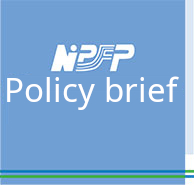Impact of FFC recommendations on Central transfers and social sector expenditures
MITA CHOUDHURY, Professor, National Institute of Public Finance and Policy, New Delhi, India. email:mita.choudhury@nipfp.org.in
JAY DEV DUBEY, Consultant, National Institute of Public Finance and Policy, New Delhi, India. email:jaydev.dubey@nipfp.org.in
|
Following the recommendations of the Fourteenth Finance Commission (FFC), the share of States in the divisible pool of taxes has increased from 32 to 42 per cent. To accommodate this increase, the Union government was expected to reduce grants-in-aid to States as the available fiscal space was inadequate to absorb the increased tax devolution. Potentially, the reduction in grants could offset the additional gain in resources through increased tax devolution to the States. Additionally, the reduction in grants could adversely impact the social sector expenditures in States as a significant proportion of these grants-in-aid was towards Centrally Sponsored Schemes (CSS) in the social sectors.
Magnitude of net gain in Central Transfers to States
Central transfers to States in the first two years of the FFC period has not been higher than the average of the Thirteenth Finance Commission period (TFC). Although Central transfers increased marginally since 2014-15, the levels of transfers in the first two years of the FFC period were still lower than the average of the TFC period. Notably, Central transfers to States in 2014-15 were the lowest in the TFC period, and most studies have measured State-level increases in Central transfers with respect to this low base year. This has induced an upward bias in the measurement of gains in existing studies. Even while providing a comparison with respect to the low base year, Revised Estimates suggest that Central transfers to GSDP ratio is likely to fall in a number of major States in the first year of the FFC period.
Change in composition of Central Transfers to States
There has been a change in the composition of Central transfers to States. Untied transfers have risen due to an increase in the tax devolution. Correspondingly, tied transfers to States have declined, albeit to a lesser extent. The contraction of tied transfers to the States has resulted in a contraction in the volume of transfers for the social sector in a number of major States. This evidence is in contrast to most of the existing studies, which have argued that tied transfers to States have increased.
Impact on social sector expenditures in States
Most States have compensated for the decline in Central grants for the social sector, and social sector expenditures are likely to increase in most States in absolute terms. As proportion of GSDP, however, it is likely that social sector expenditures will fall in most major States. It is important to note that, even before the implementation of the FFC recommendations, Central grants to States for the social sector accounted for less than a third of the total social sector expenditures in most major States.
Social sector expenditures are determined largely by States’ own fiscal priorities. With relatively higher volume of untied resources at the disposal of the States because of the FFC recommendations, the relative priority assigned by the States on social services vis-à-vis economic services will be an important factor determining the changes in social sector expenditures at the State-level. In this context, it is important to note that expenditures on Social services have received a
|
lower priority over expenditures on Economic services in the first year of the FFC award period in most of the major States.
Existing evidence is biased upwards
The magnitude of increases in Central transfers and social sector expenditures at the State-level documented in existing studies is biased upwards. Almost all the studies have drawn inferences on increases in Central transfers and social sector expenditures based on comparisons between Actuals and Revised Estimates or Revised Estimates and Budget Estimates. As Actuals are almost invariably lower than Revised Estimates and Revised Estimates lower than Budget Estimates, the increases documented in these studies are on the higher side. To eliminate this bias, the analysis here uses comparisons between Revised Estimates of Central transfers and Social Sector Expenditures for different years.
Summary
Recent evidence on the impact of the recommendations of the FFC suggests that there has been an increase in the Central transfers and social sector expenditures in a number of States in 2015-16, the first year of the FFC award period. This evidence is biased upwards due to two factors. First, much of the gains have been measured with respect to a low base year 2014-15, and secondly, inferences have been drawn based on the comparisons between Actuals and Revised Estimates or Revised Estimates and Budget Estimates between the two years. Comparing Revised Estimates for the same years for fifteen major States, we find that Central transfers and expenditures on Social Services as percentage of Gross State Domestic Product (GSDP) are likely to fall in a number of States. Besides, in most States, Social Services have received a lower priority over Economic Services in the first year of the FFC award period.
References
Accountability Initiative, (2016). State of Social Sector Expenditure in 2015-16: Summary, Accountability Initiative, Centre for Policy Research, New Delhi.
World Bank, (2016). India Development Update: Financing Double-Digit Growth, World Bank Group, (June).
Chakraborty, Pinaki (2016). Restructuring of Central Grants: Balancing Fiscal Autonomy and Fiscal Space, Economic and Political Weekly, LI(6). (February).
Kotasthane, Pranay and Varun K. Ramachandra (2016). Karnataka’s Changing Fiscal Landscape: Finances after FFC, Economic and Political Weekly, LI (33).(August).
Shetty, S. L. (2016). Underutilized Fiscal Space: Maharashtra’s Budget Post Fourteenth Finance Commission, Economic and Political Weekly, LI (21).(May).
Choudhury, Mita, Ranjan K. Mohanty, and Jay Dev Dubey (2016). Impact of the Recommendations of the 14th FC: Central Transfers and Social Sector Expenditures in the 1st Year, NIPFP WP No. 183. (November). The One pager is based on this paper.
|




